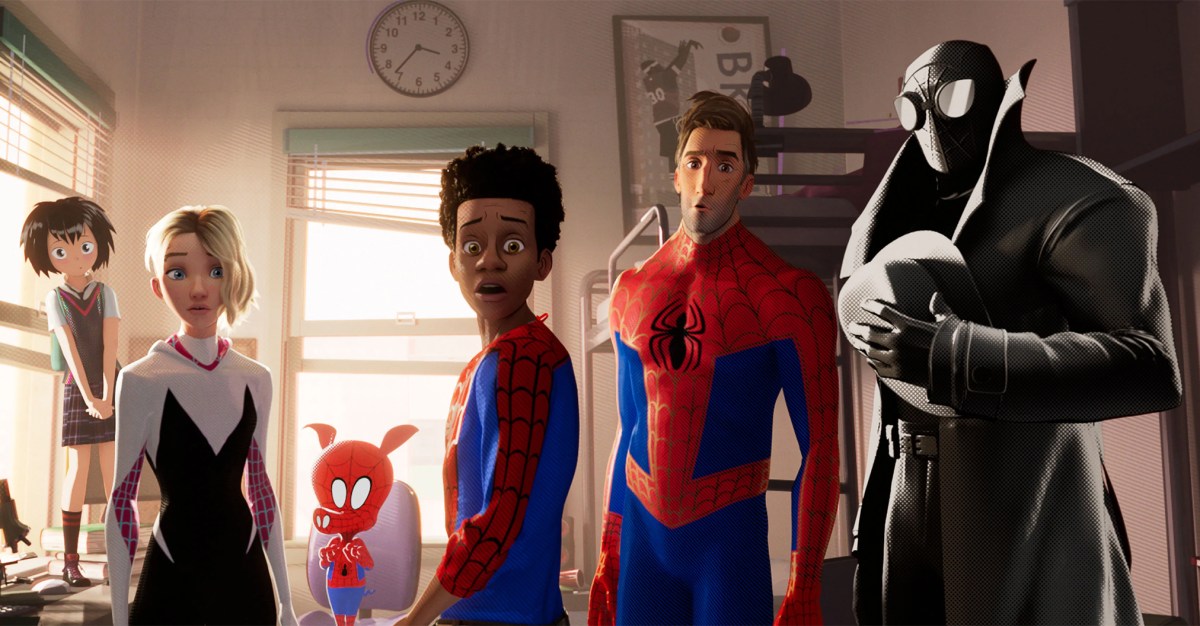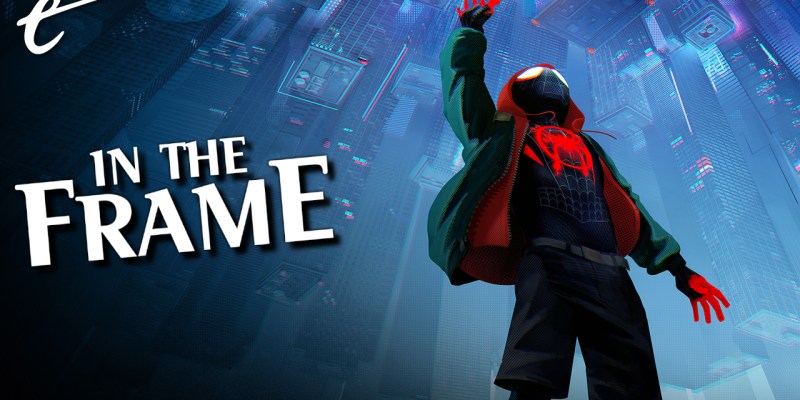Spider-Man: Into the Spider-Verse is handily the best superhero movie of the past decade. It’s also one of the rare superhero movies to actually derive formal pleasure from its comic book origins.
This is apparent in a number of ways, most obviously in the film’s visual language. The film is the most visually interesting comic book movie since Robert Rodriguez and Frank Miller’s Sin City and the most visually experimental superhero film since Ang Lee’s Hulk. It employs any number of techniques lifted directly from comic books: caption boxes, speech bubbles, split screens, scene transitions through page turns, outlines that evoke comic book inking, shading that recalls crosshatching.
Into the Spider-Verse is a movie unashamed of its comic book roots. At various points, it divides the screen in such a way as to recall the double-page spreads favored by artist Sara Pichelli, the co-creator of Miles Morales (Shameik Moore). The film also employs the classic “Kirby Krackle,” the spherical energy bubbles often employed by classic comic book artist Jack Kirby, most notably with Kingpin’s (Liev Schreiber) supercollider and Miles’ graffiti spray paint.
Into the Spider-Verse draws attention to the fact that the audience is watching a movie based on a comic book. It opens with the stamp of approval from the Comics Code Authority. Comic books appear as chapter breaks. At one point, Miles consults a comic book to read the origin of Spider-Man, discovering a narrative uncannily mirroring his own circumstances. In his opening narration, Peter Parker (Chris Pine) acknowledges, “I’m a comic book, I’m a cereal, did a Christmas album.” He is a piece of intellectual property.

Into the Spider-Verse arrived in a superhero-saturated culture. It came more than a decade after Iron Man launched the Marvel Cinematic Universe. It was released the same year as Black Panther, which would go on to be the first superhero movie to be nominated for Best Picture. In the previous decade and a half, there had been three live-action takes on Spider-Man as a character, in three separate continuities, played by Tobey Maguire, Andrew Garfield, and Tom Holland.
After Tom Holland was cast as Peter Parker in Captain America: Civil War, critics worried that they’d have to sit through another take on Spider-Man’s origin story despite the fact that they “certainly already know who the guy is and what the basic contours of his shtick are.” When Spider-Man: Homecoming writers John Francis Daley and Jonathan Goldstein promised not to replay that origin, there was a sense of relief. Some critics were done with superhero origins entirely.
Into the Spider-Verse doesn’t just understand the audience’s familiarity with superhero origins in general and Spider-Man’s origin in particular. It weaponizes it. The movie opens with a narration from Peter Parker explaining his origin, but in a way that acknowledges this is well-trodden ground. The film’s first line is: “Alright, let’s do this one last time.” After speedrunning the finer details of his origin story, Peter assures viewers, “I’m pretty sure you know the rest.” The punchline is that the film then replays this framework multiple times.
Into the Spider-Verse doesn’t just give a speedrun introduction to Peter Parker. It also provides one for his alternate universe counterpart, Peter B. Parker (Jake Johnson), and later for Gwen Stacy (Hailee Steinfeld). At one point, the film runs the origins of Peni Parker (Kimiko Glenn), Spider-Ham (John Mulaney), and Spider-Man Noir (Nicolas Cage) simultaneously. Each introduction begins with the promise that this is happening “one last time” and acknowledges the audience’s familiarity with “the rest.”

Into the Spider-Verse assumes that the audience is literate in the conventions and internal logic of the archetypal superhero narrative that had become the default mode of blockbuster storytelling over the previous decade. A veteran superhero, Peter B. Parker is almost immediately able to deduce the contours of the plot in which he finds himself just through his familiarity with the genre. He understands what is happening quicker than Miles does, despite arriving later into the story.
At one point, to override the supercollider, he asks Miles for the “goober.” Miles replies that his Peter called it “an override key.” Peter B. Parker explains, “There’s always a bypass key, a virus key, a who-cares key. I can never remember, so I always call it a goober.” Later, listening to Kingpin monologuing, he predicts, “Watch this. He’s gonna say, ‘You’ve got 24 hours.’” Within a few seconds, Kingpin has hit his mark and delivered his villainous ultimatum. It’s fairly paint-by-numbers stuff.
Into the Spider-Verse is a pointedly postmodern superhero film. “The thematic idea kind of came out of me going to a Jeff Koons retrospective at the Whitney because that guy takes, like, weird things in popular culture or historical culture and refracts them in really grotesque ways and makes them into something new,” explained co-writer Phil Lord. “And I thought, oh, that’s what our culture is like. We’re taking these superhero myths and ingesting them and creating them anew, and this movie can basically own that and be like a postmodern superhero movie where we gobble it up and refract it.”
Of course, postmodernism is just part of the fabric of modern pop culture, largely through the influence of writers and creators like Joss Whedon and the success of movies like Shrek. Characters within these movies are often drawing attention to the artificial nature of the world in which they find themselves. Audiences are often invited to experience pop culture at a level of ironic remove, with characters pointing out clichés even as films employ them.

This level of detachment can become numbing when employed as nothing more than an end to itself. This was part of the culture around the time that Into the Spider-Verse was released. A year before Into the Spider-Verse came out, Owen Gleiberman lamented, “Watching a Star Wars film (had) become a postmodern experience.” Steven Spielberg released Ready Player One a few months before Into the Spider-Verse, a suffocating catalog of pop culture references.
Contemporary pop culture can often reduce characters and ideas to nothing more than empty iconography in pursuit of hollow nostalgia. Ghostbusters was reimagined as a fantasy of rural America that can only be created in Alberta, Canada. Spider-Man: No Way Home builds as much to recreation of the classic “Spider-Man pointing meme” that Into the Spider-Verse saves for a post-credits joke as it does to any emotional denouement. In modern pop culture, this postmodernism often uses repetition to divorce symbols from meaning.
This is in some ways the nightmare of modern pop culture, one reflected on the Millennial internet where, as Elizabeth Bruenig notes, “loops of self-referential quips warp and distort with each iteration, tweaked by another user embellishing on someone else’s joke, until nothing coherent is left.” After all, the same multiverse at the heart of stories like Into the Spider-Verse and Everything Everywhere All at Once is often little more than a tool for empty corporate machinations like recasting or folding in newly acquired intellectual property.
Of course, this is a very cynical way of looking at modern pop culture, albeit one that reflects the reality of so much of the modern pop culture landscape. There is an alternative to this empty recycling of familiar iconography. There is a way to use the audience’s hypermediated understanding of these tropes and images in service of something beyond mere recognition. In the right hands, there can be meaning found within the memes.

It’s fitting that Into the Spider-Verse is a movie aimed at children, many of whom were born after the superhero boom began. They’ve grown up speaking the language of these movies and navigating the postmodern landscape of the internet. For these young people digesting culture through TikToks, gifs, and memes, the reduction of an entire narrative framework to “an easily replicated micro-narrative” doesn’t have to be a reduction. It can be a distillation.
Much of the best pop culture is able to use that audience’s understanding of narrative conventions and shorthand to dramatic effect. The Lego Movie initially appears to be a cynical piece of product promotion, but it becomes a profound meditation on who gets to tell these stories and what they say. Rick and Morty doesn’t just extrapolate from high-concept science fiction ideas, but it exponentializes them. If an audience that has grown up with these stories understands how the underpinning logic works, storytellers can play with that.
Elizabeth Sandifer has discussed the “narrative acceleration” of Steven Moffat’s Doctor Who, where the audience’s familiarity with a basic plot structure allows aspects to be “sped through because (they’re) not actually the part of the story that matters.” “The Great Game,” the first season finale of Moffat’s Sherlock, burns through five mysteries in 90 minutes, because it’s not actually a show about mysteries, instead using them as a framework to tell a story about the kind of person that Sherlock (Benedict Cumberbatch) must be.

Spider-Man: Into the Spider-Verse is part of this postmodern tradition, which traces its roots back through the pop art of artists like Andy Warhol and the early sampling done by hip-hop artists. It is fitting that Miles is a graffiti artist, given that urban art is built around many of the same principles of taking familiar iconography and using it to enrich the meaning of a new work. At one point, an onlooker is confused by a strange object thrown through the collider, musing, “Yeah, I think it’s a Banksy.”
In stripping the familiar beats of a Spider-Man story down to their essence, Into the Spider-Verse is able to cover a lot of narrative ground quickly. However, it’s also able to find a fundamental truth in the idea of Spider-Man, to distill the character down to a central idea that extends beyond the finer details of continuity or lore. The specifics aren’t important. They are fungible. Spider-Man isn’t just one thing. Spider-Man isn’t just Peter Parker. Spider-Man is an idea with an infinite number of possible applications. That is what matters.
Into the Spider-Verse speedruns the beats of its Spider-Man story because it’s not a Spider-Man story. It is a story about Spider-Man. It’s about the essence of the character, how he “always (finds) a way to come back.” However, it’s also about how that immortality derives from the universality of the character, how “anyone can wear the mask.” Spider-Man is an idea, perhaps even a meme, but one with meaning.
